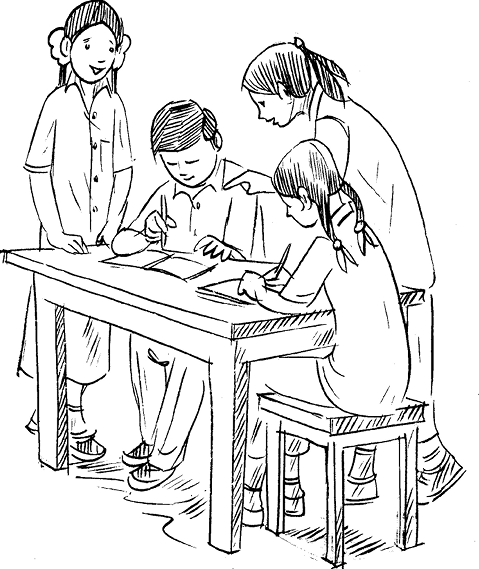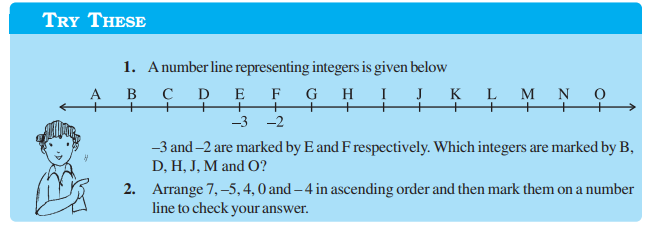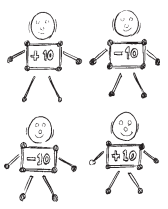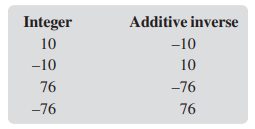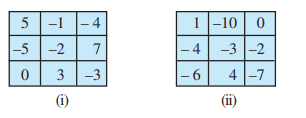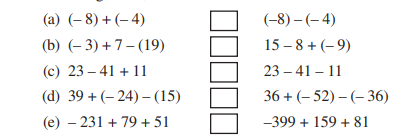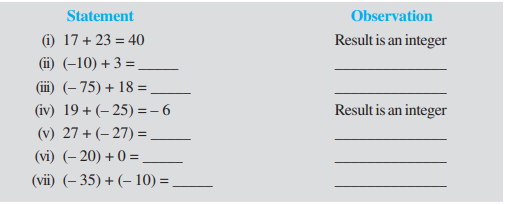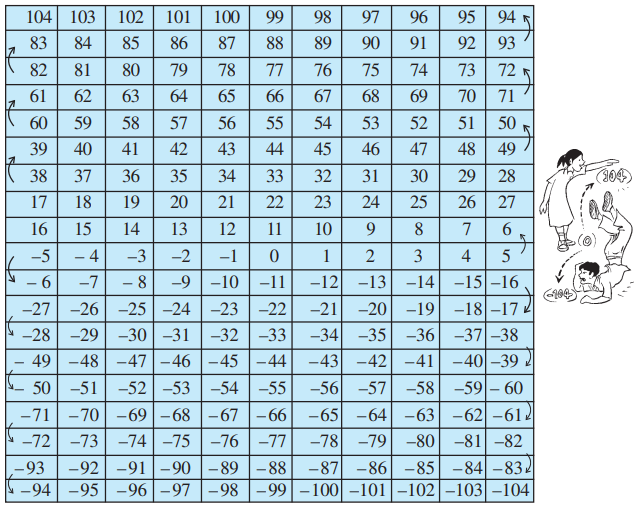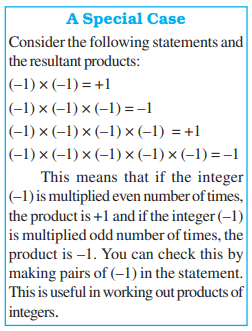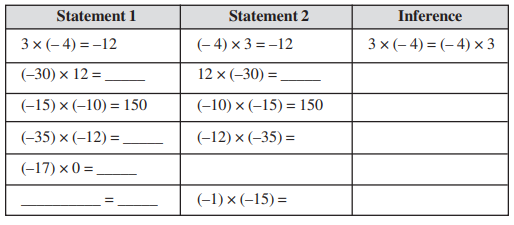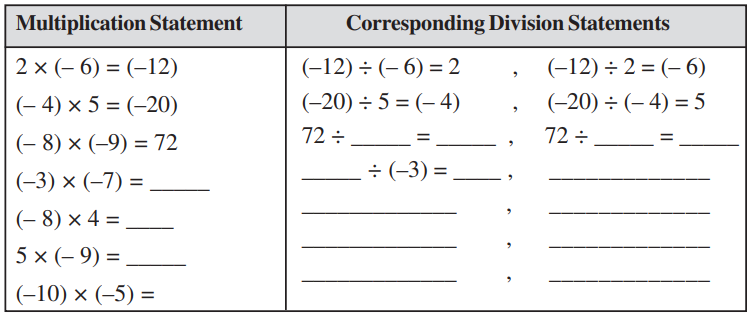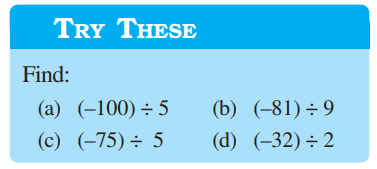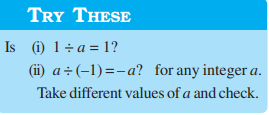Table of Contents

Chapter 1
Integers
1.1 Introduction
We have learnt about whole numbers and integers in Class VI. We know that integers form a bigger collection of numbers which contains whole numbers and negative numbers. What other differences do you find between whole numbers and integers? In this chapter, we will study more about integers, their properties and operations. First of all, we will review and revise what we have done about integers in our previous class.
1.2 Recall
We know how to represent integers on a number line. Some integers are marked on the number line given below.

Some points are marked with integers on the following number line. Write these integers in descending order.

The descending order of these integers is 14, 8, 3, ...
The above number line has only a few integers filled. Write appropriate numbers at each dot.
We have done addition and subtraction of integers in our previous class. Read the following statements.
On a number line when we
(i) add a positive integer, we move to the right.
(ii) add a negative integer, we move to the left.
(iii) subtract a positive integer, we move to the left.
(iv) subtract a negative integer, we move to the right.
State whether the following statements are correct or incorrect. Correct those which are wrong:
(i) When two positive integers are added we get a positive integer.
(ii) When two negative integers are added we get a positive integer.
(iii) When a positive integer and a negative integer are added, we always get a negative integer.
(iv) Additive inverse of an integer 8 is (– 8) and additive inverse of (– 8) is 8.
(v) For subtraction, we add the additive inverse of the integer that is being subtracted, to the other integer.
(vi) (–10) + 3 = 10 – 3
(vii) 8 + (–7) – (– 4) = 8 + 7 – 4
Compare your answers with the answers given below:
(i) Correct. For example:
(a) 56 + 73 = 129 (b) 113 + 82 = 195 etc.
Construct five more examples in support of this statement.
(ii) Incorrect, since (– 6) + (– 7) = – 13, which is not a positive integer. The correct statement is: When two negative integers are added we get a negative integer.
For example,
(a) (– 56) + (– 73) = – 129 (b) (– 113) + (– 82) = – 195, etc.
Construct five more examples on your own to verify this statement.
(iii) Incorrect, since – 9 + 16 = 7, which is not a negative integer. The correct statement is : When one positive and one negative integers are added, we take their difference and place the sign of the bigger integer. The bigger integer is decided by ignoring the signs of both the integers. For example:
(a) (– 56) + (73) = 17 (b) (– 113) + 82 = – 31
(c) 16 + (– 23) = – 7 (d) 125 + (– 101) = 24
Construct five more examples for verifying this statement.
(iv) Correct. Some other examples of additive inverse are as given below:
Thus, the additive inverse of any integer a is – a and additive inverse of (– a) is a.
(v) Correct. Subtraction is opposite of addition and therefore, we add the additive inverse of the integer that is being subtracted, to the other integer. For example:
(a) 56 – 73 = 56 + additive inverse of 73 = 56 + (–73) = –17
(b) 56 – (–73) = 56 + additive inverse of (–73) = 56 + 73 = 129
(c) (–79) – 45 = (–79) + (– 45) = –124
(d) (–100) – (–172) = –100 + 172 = 72 etc.
Write atleast five such examples to verify this statement.
Thus, we find that for any two integers a and b,
a – b = a + additive inverse of b = a + (– b)
and a – (– b) = a + additive inverse of (– b) = a + b
(vi) Incorrect, since (–10) + 3 = –7 and 10 – 3 = 7
therefore, (–10) + 3 ≠ 10 – 3
(vii) Incorrect, since, 8 + (–7) – (– 4) = 8 + (–7) + 4 = 1 + 4 = 5
and 8 + 7 – 4 = 15 – 4 = 11
However, 8 + (–7) – (– 4) = 8 – 7 + 4
Exercise 1.1
1. Following number line shows the temperature in degree celsius (°C) at different places on a particular day.

(a) Observe this number line and write the temperature of the places marked on it.
(b) What is the temperature difference between the hottest and the coldest places among the above?
(c) What is the temperature difference between Lahulspiti and Srinagar?
(d) Can we say temperature of Srinagar and Shimla taken together is less than the temperature at Shimla? Is it also less than the temperature at Srinagar?
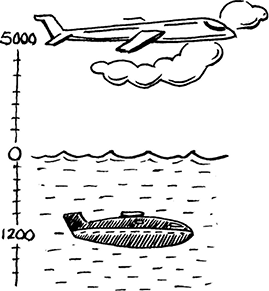
3. At Srinagar temperature was – 5°C on Monday and then it dropped by 2°C on Tuesday. What was the temperature of Srinagar on Tuesday? On Wednesday, it rose by 4°C. What was the temperature on this day?
4. A plane is flying at the height of 5000 m above the sea level. At a particular point, it is exactly above a submarine floating 1200 m below the sea level. What is the vertical distance between them?
5. Mohan deposits ` 2,000 in his bank account and withdraws ` 1,642 from it, the next day. If withdrawal of amount from the account is represented by a negative integer, then how will you represent the amount deposited? Find the balance in Mohan’s account after the withdrawal.
6. Rita goes 20 km towards east from a point A to the point B. From B, she moves 30 km towards west along the same road. If the distance towards east is represented by a positive integer then, how will you represent the distance travelled towards west? By which integer will you represent her final position from A?

7. In a magic square each row, column and diagonal have the same sum. Check which of the following is a magic square.
8. Verify a – (– b) = a + b for the following values of a and b.
(i) a = 21, b = 18 (ii) a = 118, b = 125
(iii) a = 75, b = 84 (iv) a = 28, b = 11
9. Use the sign of >, < or = in the box to make the statements true.

10. A water tank has steps inside it. A monkey is sitting on the topmost step (i.e., the first step). The water level is at the ninth step.
(i) He jumps 3 steps down and then jumps back 2 steps up. In how many jumps will he reach the water level?
(ii) After drinking water, he wants to go back. For this, he jumps 4 steps up and then jumps back 2 steps down in every move. In how many jumps will he reach back the top step?
(iii) If the number of steps moved down is represented by negative integers and the number of steps moved up by positive integers, represent his moves in part (i) and (ii) by completing the following; (a) – 3 + 2 – ... = – 8
(b) 4 – 2 + ... = 8. In (a) the sum (– 8) represents going down by eight steps. So, what will the sum 8 in (b) represent?
1.3 Properties of Addition and Subtraction of Integers
1.3.1 Closure under Addition
We have learnt that sum of two whole numbers is again a whole number. For example, 17 + 24 = 41 which is again a whole number. We know that, this property is known as the closure property for addition of the whole numbers.

Let us see whether this property is true for integers or not.
Following are some pairs of integers. Observe the following table and complete it.
What do you observe? Is the sum of two integers always an integer?
Did you find a pair of integers whose sum is not an integer?
Since addition of integers gives integers, we say integers are closed under addition.
In general, for any two integers a and b, a + b is an integer.
1.3.2 Closure under Subtraction
What happens when we subtract an integer from another integer? Can we say that their difference is also an integer?
Observe the following table and complete it:
What do you observe? Is there any pair of integers whose difference is not an integer? Can we say integers are closed under subtraction? Yes, we can see that integers are closed under subtraction.
Thus, if a and b are two integers then a – b is also an intger. Do the whole numbers satisfy this property?
1.3.3 Commutative Property
We know that 3 + 5 = 5 + 3 = 8, that is, the whole numbers can be added in any order. In other words, addition is commutative for whole numbers.
Can we say the same for integers also?
We have 5 + (– 6) = –1 and (– 6) + 5 = –1
So, 5 + (– 6) = (– 6) + 5
Are the following equal?
(i) (– 8) + (– 9) and (– 9) + (– 8)
(ii) (– 23) + 32 and 32 + (– 23)
(iii) (– 45) + 0 and 0 + (– 45)
Try this with five other pairs of integers. Do you find any pair of integers for which the sums are different when the order is changed? Certainly not. We say that addition is commutative for integers.
In general, for any two integers a and b, we can say
a + b = b + a
We know that subtraction is not commutative for whole numbers. Is it commutative for integers?
Consider the integers 5 and (–3).
Is 5 – (–3) the same as (–3) –5? No, because 5 – ( –3) = 5 + 3 = 8, and (–3) – 5 = – 3 – 5 = – 8.
Take atleast five different pairs of integers and check this.
We conclude that subtraction is not commutative for integers.
1.3.4 Associative Property
Observe the following examples:
Consider the integers –3, –2 and –5.
Look at (–5) + [(–3) + (–2)] and [(–5) + (–3)] + (–2).
In the first sum (–3) and (–2) are grouped together and in the second (–5) and (–3) are grouped together. We will check whether we get different results.


(–5) + [(–3) + (–2)] [(–5) + (–3)] + (–2)
In both the cases, we get –10.
i.e., (–5) + [(–3) + (–2)] = [(–5) + (–2)] + (–3)
Similarly consider –3 , 1 and –7.
( –3) + [1 + (–7)] = –3 + __________ = __________
[(–3) + 1] + (–7) = –2 + __________ = __________
Is (–3) + [1 + (–7)] same as [(–3) + 1] + (–7)?
Take five more such examples. You will not find any example for which the sums are different. Addition is associative for integers.
In general for any integers a, b and c, we can say
a + (b + c) = (a + b) + c
1.3.5 Additive Identity
When we add zero to any whole number, we get the same whole number. Zero is an additive identity for whole numbers. Is it an additive identity again for integers also?
Observe the following and fill in the blanks:
(i) (– 8) + 0 = – 8 (ii) 0 + (– 8) = – 8
(iii) (–23) + 0 = _____ (iv) 0 + (–37) = –37
(v) 0 + (–59) = _____ (vi) 0 + _____ = – 43
(vii) – 61 + _____ = – 61 (viii) _____ + 0 = _____
The above examples show that zero is an additive identity for integers.
You can verify it by adding zero to any other five integers.
In general, for any integer a
a + 0 = a = 0 + a
Example 1 Write down a pair of integers whose
(a) sum is –3 (b) difference is –5
(c) difference is 2 (d) sum is 0

Solution (a) (–1) + (–2) = –3 or (–5) + 2 = –3
(b) (–9) – (– 4) = –5 or (–2) – 3 = –5
(c) (–7) – (–9) = 2 or 1 – (–1) = 2
(d) (–10) + 10 = 0 or 5 + (–5) = 0
Can you write more pairs in these examples?
Exercise 1.2

1. Write down a pair of integers whose:
(a) sum is –7 (b) difference is –10 (c) sum is 0
2. (a) Write a pair of negative integers whose difference gives 8.
(b) Write a negative integer and a positive integer whose sum is –5.
(c) Write a negative integer and a positive integer whose difference is –3.
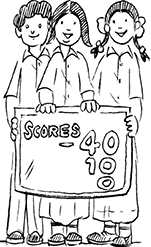
3. In a quiz, team A scored – 40, 10, 0 and team B scored 10, 0, – 40 in three successive rounds. Which team scored more? Can we say that we can add integers in any order?
4. Fill in the blanks to make the following statements true:
(i) (–5) + (– 8) = (– 8) + (............)
(ii) –53 + ............ = –53
(iii) 17 + ............ = 0
(iv) [13 + (– 12)] + (............) = 13 + [(–12) + (–7)]
(v) (– 4) + [15 + (–3)] = [– 4 + 15] + ............
1.4 Multiplication of Integers
We can add and subtract integers. Let us now learn how to multiply integers.
1.4.1 Multiplication of a Positive and a Negative Integer
We know that multiplication of whole numbers is repeated addition. For example,
5 + 5 + 5 = 3 × 5 = 15
Can you represent addition of integers in the same way?
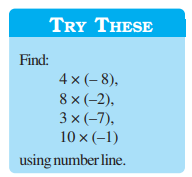

But we can also write
(–5) + (–5) + (–5) = 3 × (–5)
Therefore, 3 × (–5) = –15
Similarly (– 4) + (– 4) + (– 4) + (– 4) + (– 4) = 5 × (– 4) = –20

And (–3) + (–3) + (–3) + (–3) = __________ = __________
Also, (–7) + (–7) + (–7) = __________ = __________
Let us see how to find the product of a positive integer and a negative integer without using number line.
Let us find 3 × (–5) in a different way. First find 3 × 5 and then put minus sign (–) before the product obtained. You get –15. That is we find – (3 × 5) to get –15.
Similarly, 5 × (– 4) = – (5×4) = – 20.
Find in a similar way,
4 × (– 8) = _____ = _____, 3 × (– 7) = _____ = _____
6 × (– 5) = _____ = _____, 2 × (– 9) = _____ = _____
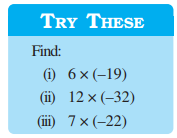
10 × (– 43) = _____ – (10 × 43) = – 430
Till now we multiplied integers as (positive integer) × (negative integer).
Let us now multiply them as (negative integer) × (positive integer).
We first find –3 × 5.
To find this, observe the following pattern:
 We have, 3 × 5 = 15
We have, 3 × 5 = 15 2 × 5 = 10 = 15 – 5
1 × 5 = 5 = 10 – 5
0 × 5 = 0 = 5 – 5
So, –1 × 5 = 0 – 5 = –5
–2 × 5 = –5 – 5 = –10
–3 × 5 = –10 – 5 = –15
We already have 3 × (–5) = –15
So we get (–3) × 5 = –15 = 3 × (–5)
Using such patterns, we also get (–5) × 4 = –20 = 5 × (– 4)
Using patterns, find (– 4) × 8, (–3) × 7, (– 6) × 5 and (– 2) × 9
Check whether, (– 4) × 8 = 4 × (– 8), (– 3) × 7 = 3 × (–7), (– 6) × 5 = 6 × (– 5)
and (– 2) × 9 = 2 × (– 9)
Using this we get, (–33) × 5 = 33 × (–5) = –165
We thus find that while multiplying a positive integer and a negative integer, we multiply them as whole numbers and put a minus sign (–) before the product. We thus get a negative integer.
In general, for any two positive integers a and b we can say
a × (– b) = (– a) × b = – (a × b)
1.4.2 Multiplication of two Negative Integers
Can you find the product (–3) × (–2)?
Observe the following:

–3 × 4 = – 12
–3 × 3 = –9 = –12 – (–3)
–3 × 2 = – 6 = –9 – (–3)
–3 × 1 = –3 = – 6 – (–3)
–3 × 0 = 0 = –3 – (–3)
–3 × –1 = 0 – (–3) = 0 + 3 = 3
–3 × –2 = 3 – (–3) = 3 + 3 = 6
Do you see any pattern? Observe how the products change.
Based on this observation, complete the following:
–3 × –3 = _____ –3 × – 4 = _____
Now observe these products and fill in the blanks:
– 4 × 4 = –16
– 4 × 3 = –12 = –16 + 4
– 4 × 2 = _____ = –12 + 4
– 4 × 1 = _____
– 4 × 0 = _____
– 4 × (–1) = _____
– 4 × (–2) = _____
– 4 × (–3) = _____
From these patterns we observe that,
(–3) × (–1) = 3 = 3 × 1
(–3) × (–2) = 6 = 3 × 2
(–3) × (–3) = 9 = 3 × 3
and (– 4) × (–1) = 4 = 4 × 1
So, (– 4) × (–2) = 4 × 2 = _____
(– 4) × (–3) = _____ = _____
So observing these products we can say that the product of two negative integers is a positive integer. We multiply the two negative integers as whole numbers and put the positive sign before the product.
Thus, we have (–10) × (–12) = + 120 = 120
Similarly (–15) × (– 6) = + 90 = 90
In general, for any two positive integers a and b,
(– a) × (– b) = a × b
Game 1
(i) Take a board marked from –104 to 104 as shown in the figure.
(ii) Take a bag containing two blue and two red dice. Number of dots on the blue dice indicate positive integers and number of dots on the red dice indicate negative integers.
(iii) Every player will place his/her counter at zero.
(iv) Each player will take out two dice at a time from the bag and throw them.
(v) After every throw, the player has to multiply the numbers marked on the dice.
(vi) If the product is a positive integer then the player will move his counter towards 104; if the product is a negative integer then the player will move his counter towards –104.
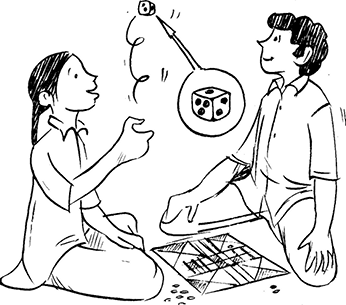 (vii) The player who reaches either -104 or 104 first is the winner.
(vii) The player who reaches either -104 or 104 first is the winner. 
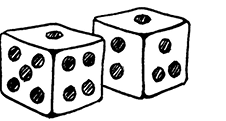
1.4.3 Product of three or more Negative Integers
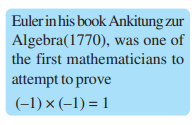
We observed that the product of two negative integers is a positive integer. What will be the product of three negative integers? Four negative integers? Let us observe the following examples:
(a) (– 4) × (–3) = 12
(b) (– 4) × (–3) × (–2) = [(– 4) × (–3)] × (–2) = 12 × (–2) = – 24
(c) (– 4) × (–3) × (–2) × (–1) = [(– 4) × (–3) × (–2)] × (–1) = (–24) × (–1)
(d) (–5) × [(–4) × (–3) × (–2) × (–1)] = (–5) × 24 = –120
From the above products we observe that
(a) the product of two negative integers is a positive integer;
(b) the product of three negative integers is a negative integer.
(c) product of four negative integers is a positive integer.
What is the product of five negative integers in (d)?
So what will be the product of six negative integers?
We further see that in (a) and (c) above, the number of negative integers that are multiplied are even [two and four respectively] and the product obtained in (a) and (c) are positive integers. The number of negative integers that are multiplied in (b) and (d) is odd and the products obtained in (b) and (d) are negative integers.
We find that if the number of negative integers in a product is even, then the product is a positive integer; if the number of negative integers in a product is odd, then the product is a negative integer.
Justify it by taking five more examples of each kind.
Think, Discuss and Write

(i) The product (–9) × (–5) × (– 6)×(–3) is positive whereas the product (–9) × ( –5) × 6 × (–3) is negative. Why?
(ii) What will be the sign of the product if we multiply together:
(a) 8 negative integers and 3 positive integers?
(b) 5 negative integers and 4 positive integers?
(c) (–1), twelve times?
(d) (–1), 2 m times, m is a natural number?
1.5 Properties of Multiplication of Integers
1.5.1 Closure under Multiplication
1. Observe the following table and complete it:
What do you observe? Can you find a pair of integers whose product is not an integer? No. This gives us an idea that the product of two integers is again an integer. So we can say that integers are closed under multiplication.
In general,
a × b is an integer, for all integers a and b.
Find the product of five more pairs of integers and verify the above statement.
1.5.2 Commutativity of Multiplication
We know that multiplication is commutative for whole numbers. Can we say, multiplication is also commutative for integers?
Observe the following table and complete it:
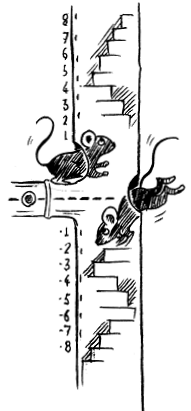
What are your observations? The above examples suggest multiplication is commutative for integers. Write five more such examples and verify. In general, for any two integers a and b,
a × b = b × a
1.5.3 Multiplication by Zero
We know that any whole number when multiplied by zero gives zero. Observe the following products of negative integers and zero. These are obtained from the patterns done earlier.
(–3) × 0 = 0
0 × (– 4) = 0
– 5 × 0 = _____
0 × (– 6) = _____
This shows that the product of a negative integer and zero is zero. In general, for any integer a,
a × 0 = 0 × a = 0
1.5.4 Multiplicative Identity
We know that 1 is the multiplicative identity for whole numbers.
Check that 1 is the multiplicative identity for integers as well. Observe the following products of integers with 1.
(–3) × 1 = –3 1 × 5 = 5
(– 4) × 1 = _____ 1 × 8 = _____
1 × (–5) = _____ 3 × 1 = _____
1 × (– 6) = _____ 7 × 1 = _____
This shows that 1 is the multiplicative identity for integers also.
In general, for any integer a we have,
a × 1 = 1 × a = a
What happens when we multiply any integer with –1? Complete the following:
(–3) × (–1) = 3
3 × (–1) = –3
(– 6) × (–1) = _____
(–1) × 13 = _____
(–1) × (–25) = _____
18 × (–1) = _____
What do you observe?
Can we say –1 is a multiplicative identity of integers? No.
1.5.5 Associativity for Multiplication
Consider –3, –2 and 5.
Look at [(–3) × (–2)] × 5 and (–3) × [(–2) × 5].
In the first case (–3) and (–2) are grouped together and in the second (–2) and 5 are grouped together.

We see that [(–3) × (–2)] × 5 = 6 × 5 = 30
and (–3) × [(–2) × 5] = (–3) × (–10) = 30
So, we get the same answer in both the cases.
Thus, [(–3) × (–2)] × 5 = (–3) × [(–2) × 5]
Look at this and complete the products:
7 × [(– 6) × 4] = 7 × __________ = __________
Is [7 × (– 6)] × 4 = 7 × [(– 6) × 4]?
Does the grouping of integers affect the product of integers? No.
In general, for any three integers a, b and c
(a × b) × c = a × (b × c)
Take any five values for a, b and c each and verify this property.
Thus, like whole numbers, the product of three integers does not depend upon the grouping of integers and this is called the associative property for multiplication of integers.
1.5.6 Distributive Property
We know
16 × (10 + 2) = (16 × 10) + (16 × 2) [Distributivity of multiplication over addition]
Let us check if this is true for integers also.
Observe the following:
(a) (–2) × (3 + 5) = –2 × 8 = –16
and [(–2) × 3] + [(–2) × 5] = (– 6) + (–10) = –16
So, (–2) × (3 + 5) = [(–2) × 3] + [(–2) × 5]
(b) (– 4) × [(–2) + 7] = (– 4) × 5 = –20
and [(– 4) × (–2)] + [(– 4) × 7] = 8 + (–28) = –20
So, (– 4) × [(–2) + 7] = [(– 4) × (–2)] + [(– 4) × 7]
(c) (– 8) × [(–2) + (–1)] = (– 8) × (–3) = 24
and [(– 8) × (–2)] + [(– 8) × (–1)] = 16 + 8 = 24
So, (– 8) × [(–2) + (–1)] = [(– 8) × (–2)] + [(– 8) × (–1)]
Can we say that the distributivity of multiplication over addition is true for integers also? Yes.
In general, for any integers a, b and c,
a × (b + c) = a × b + a × c
Take atleast five different values for each of a, b and c and verify the above Distributive property.
Let us check:
4 × (3 – 8) = 4 × (–5) = –20
4 × 3 – 4 × 8 = 12 – 32 = –20
So, 4 × (3 – 8) = 4 × 3 – 4 × 8.
Look at the following:
( –5) × [( – 4) – ( – 6)] = ( –5) × 2 = –10
[( –5) × ( – 4)] – [ ( –5) × ( – 6)] = 20 – 30 = –10
So, ( –5) × [( – 4) – ( – 6)] = [( –5) × ( – 4)] – [ ( –5) × ( – 6)]
Check this for ( –9) × [ 10 – ( –3)] and [( –9) × 10 ] – [ ( –9) × ( –3)]
You will find that these are also equal.
In general, for any three integers a, b and c,
a × (b – c) = a × b – a × c
Take atleast five different values for each of a, b and c and verify this property.

Consider the following:
(i) We can find (–25) × 37 × 4 as
[(–25) × 37] × 4 = (– 925)× 4 = –3700
Or, we can do it this way,
(–25) × 37 × 4 = (–25) × 4 × 37 = [(–25) × 4] × 37 = (–100) × 37 = –3700
Which is the easier way?
Obviously the second way is easier because multiplication of (–25) and 4 gives –100 which is easier to multiply with 37. Note that the second way involves commutativity and associativity of integers.
So, we find that the commutativity, associativity and distributivity of integers help to make our calculations simpler. Let us further see how calculations can be made easier using these properties.
(ii) Find 16 × 12
16 × 12 can be written as 16 × (10 + 2).
16 × 12 = 16 × (10 + 2) = 16 × 10 + 16 × 2 = 160 + 32 = 192
(iii) (–23) × 48 = (–23) × [50 – 2] = (–23) × 50 – (–23) × 2 = (–1150) – (– 46)
= –1104
(iv) (–35) × (–98) = (–35) × [(–100) + 2] = (–35) × (–100) + (–35) × 2
= 3500 + (–70) = 3430
(v) 52 × (– 8) + (–52) × 2
(–52) × 2 can also be written as 52 × (–2).
Therefore, 52 × (– 8) + (–52) × 2 = 52 × (– 8) + 52 × (–2)
= 52 × [(– 8) + (–2)] = 52 × [(–10)] = –520
Solution
(i) (–18) × (–10) × 9 = [(–18) × (–10)] × 9 = 180 × 9 = 1620
(ii) (–20) × (–2) × (–5) × 7 = – 20 × (–2 × –5) × 7 = [–20 × 10] × 7 = – 1400
(iii) (–1) × (–5) × (– 4) × (– 6) = [(–1) × (–5)] × [(– 4) × (– 6)] = 5 × 24 = 120
Example 3 Verify (–30) × [13 + (–3)] = [(–30) × 13] + [(–30) × (–3)]
Solution (–30) × [13 + (–3)] = (–30) × 10 = –300
[(–30) × 13] + [(–30) × (–3)] = –390 + 90 = –300
So, (–30) × [13 + (–3)] = [(–30) × 13] + [(–30) × (–3)]
Example 4 In a class test containing 15 questions, 4 marks are given for every correct answer and (–2) marks are given for every incorrect answer. (i) Gurpreet attempts all questions but only 9 of her answers are correct. What is her total score? (ii) One of her friends gets only 5 answers correct. What will be her score?
Solution
(i) Marks given for one correct answer = 4
So, marks given for 9 correct answers = 4 × 9 = 36
Marks given for one incorrect answer = – 2
So, marks given for 6 = (15 – 9) incorrect answers = (–2) × 6 = –12
Therefore, Gurpreet’s total score = 36 + ( –12) = 24
(ii) Marks given for one correct answer = 4
So, marks given for 5 correct answers = 4 × 5 = 20
Marks given for one incorrect answer = (–2)
So, marks given for 10 (=15 – 5) incorrect answers = (–2) × 10 = –20
Therefore, her friend’s total score = 20 + ( –20) = 0
Example 5 Suppose we represent the distance above the ground by a positive integer and that below the ground by a negative integer, then answer the following:
(i) An elevator descends into a mine shaft at the rate of 5 metre per minute. What will be its position after one hour?
(ii) If it begins to descend from 15 m above the ground, what will be its position after 45 minutes?
Solution
(i) Since the elevator is going down, so the distance covered by it will be represented by a negative integer.
Change in position of the elevator in one minute = – 5 m
Position of the elevator after 60 minutes = (–5) × 60 = – 300 m, i.e., 300 m below down from the starting position of elevator.
(ii) Change in position of the elevator in 45 minutes = (–5) × 45 = –225 m, i.e., 225 m below ground level.
So, the final position of the elevator = –225 + 15 = –210 m, i.e., 210 m below ground level.
Exercise 1.3

1. Find each of the following products:
(a) 3 × (–1) (b) (–1) × 225
(c) (–21) × (–30) (d) (–316) × (–1)
(e) (–15) × 0 × (–18) (f) (–12) × (–11) × (10)
(g) 9 × (–3) × (– 6) (h) (–18) × (–5) × (– 4)
(i) (–1) × (–2) × (–3) × 4 (j) (–3) × (–6) × (–2) × (–1)
2. Verify the following:
(a) 18 × [7 + (–3)] = [18 × 7] + [18 × (–3)]
(b) (–21) × [(– 4) + (– 6)] = [(–21) × (– 4)] + [(–21) × (– 6)]
3. (i) For any integer a, what is (–1) × a equal to?
(ii) Determine the integer whose product with (–1) is
(a) –22 (b) 37 (c) 0
4. Starting from (–1) × 5, write various products showing some pattern to show
(–1) × (–1) = 1.
5. Find the product, using suitable properties:
(a) 26 × (– 48) + (– 48) × (–36) (b) 8 × 53 × (–125)
(c) 15 × (–25) × (– 4) × (–10) (d) (– 41) × 102
(e) 625 × (–35) + (– 625) × 65 (f) 7 × (50 – 2)
(g) (–17) × (–29) (h) (–57) × (–19) + 57
6. A certain freezing process requires that room temperature be lowered from 40°C at the rate of 5°C every hour. What will be the room temperature 10 hours after the process begins?
7. In a class test containing 10 questions, 5 marks are awarded for every correct answer and (–2) marks are awarded for every incorrect answer and 0 for questions not attempted.
(i) Mohan gets four correct and six incorrect answers. What is his score?
(ii) Reshma gets five correct answers and five incorrect answers, what is her score?
(iii) Heena gets two correct and five incorrect answers out of seven questions she attempts. What is her score?
8. A cement company earns a profit of ` 8 per bag of white cement sold and a loss of
` 5 per bag of grey cement sold.
(a) The company sells 3,000 bags of white cement and 5,000 bags of grey cement in a month. What is its profit or loss?
(b) What is the number of white cement bags it must sell to have neither profit nor loss, if the number of grey bags sold is 6,400 bags.
9. Replace the blank with an integer to make it a true statement.
(a) (–3) × _____ = 27 (b) 5 × _____ = –35
(c) _____ × (– 8) = –56 (d) _____ × (–12) = 132
1.6 Division of Integers
We know that division is the inverse operation of multiplication. Let us see an example for whole numbers.
Since 3 × 5 = 15
So 15 ÷ 5 = 3 and 15 ÷ 3 = 5
Similarly, 4 × 3 = 12 gives 12 ÷ 4 = 3 and 12 ÷ 3 = 4
We can say for each multiplication statement of whole numbers there are two division statements.
Can you write multiplication statement and its corresponding divison statements for integers?
Observe the following and complete it.
From the above we observe that :
(–12) ÷ 2 = (– 6)
(–20) ÷ 5 = (– 4)
(–32) ÷ 4 = (– 8)
(– 45) ÷ 5 = (– 9)
We observe that when we divide a negative integer by a positive integer, we divide them as whole numbers and then put a minus sign (–) before the quotient.
We also observe that:
72 ÷ (–8) = –9 and 50 ÷ (–10) = –5
72 ÷ (–9) = – 8 50 ÷ (–5) = –10
So we can say that when we divide a positive integer by a negative integer, we first divide them as whole numbers and then put a minus sign (–) before the quotient.
In general, for any two positive integers a and b
a ÷ (–b) = (–a) ÷ b where b ≠ 0
divide them as whole numbers and then put a positive sign (+).
In general, for any two positive integers a and b
(– a) ÷ (–b) = a ÷ b where b ≠ 0

Justify it by taking five more examples of your own.
- We know that division is not commutative for whole numbers. Let us check it for integers also.
You can see from the table that (– 8) ÷ (– 4) ≠ (– 4) ÷ (– 8).
Is (– 9) ÷ 3 the same as 3 ÷ (– 9)?
Is (– 30) ÷ (– 6) the same as (– 6) ÷ (– 30)?
Can we say that division is commutative for integers? No.
You can verify it by taking five more pairs of integers.
- Like whole numbers, any integer divided by zero is meaningless and zero divided by an integer other than zero is equal to zero i.e., for any integer a, a ÷ 0 is not defined but 0 ÷ a = 0 for a ≠ 0.
- When we divide a whole number by 1 it gives the same whole number. Let us check whether it is true for negative integers also.
Observe the following :
(– 8) ÷ 1 = (– 8) (–11) ÷ 1 = –11 (–13) ÷ 1 = –13
(–25) ÷ 1 = ____ (–37) ÷ 1 = ____ (– 48) ÷ 1 = ____
This shows that negative integer divided by 1 gives the same negative integer.
So, any integer divided by 1 gives the same integer.
In general, for any integer a,

What happens when we divide any integer by (–1)? Complete the following table
(– 8) ÷ (–1) = 8 11 ÷ (–1) = –11 13 ÷ (–1) = ____
(–25) ÷ (–1) = ____ (–37) ÷ (–1) = ____ – 48 ÷ (–1) = ____
What do you observe?
We can say that if any integer is divided by (–1) it does not give the same integer.
Can we say [(–16) ÷ 4] ÷ (–2) is the same as
(–16) ÷ [4 ÷ (–2)]?
We know that [(–16) ÷ 4] ÷ (–2) = (– 4) ÷ (–2) = 2
and (–16) ÷ [4 ÷ (–2)] = (–16) ÷ (–2) = 8
So [(–16) ÷ 4] ÷ (–2) ≠ (–16) ÷ [4 ÷ (–2)]
Can you say that division is associative for integers? No.
Verify it by taking five more examples of your own.
Example 6 In a test (+5) marks are given for every correct answer and (–2) marks are given for every incorrect answer. (i) Radhika answered all the questions and scored 30 marks though she got 10 correct answers. (ii) Jay also answered all the questions and scored (–12) marks though he got 4 correct answers. How many incorrect answers had they attempted?

Solution
(i) Marks given for one correct answer = 5
So, marks given for 10 correct answers = 5 × 10 = 50
Radhika’s score = 30
Marks obtained for incorrect answers = 30 – 50 = – 20
Marks given for one incorrect answer = (–2)
Therefore, number of incorrect answers = (–20) ÷ (–2) = 10
(ii) Marks given for 4 correct answers = 5 × 4 = 20
Jay’s score = –12
Marks obtained for incorrect answers = –12 – 20 = – 32
Marks given for one incorrect answer = (–2)
Therefore number of incorrect answers = (–32) ÷ (–2) = 16
Example 7 A shopkeeper earns a profit of ` 1 by selling one pen and incurs a loss of 40 paise per pencil while selling pencils of her old stock.
(i) In a particular month she incurs a loss of ` 5. In this period, she sold 45 pens. How many pencils did she sell in this period?
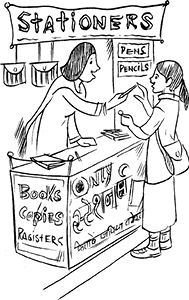
(ii) In the next month she earns neither profit nor loss. If she sold 70 pens, how many pencils did she sell?
Solution
(i) Profit earned by selling one pen = ` 1
Profit earned by selling 45 pens = ` 45, which we denote by + ` 45
Total loss given = ` 5, which we denote by – ` 5
Profit earned + Loss incurred = Total loss
Therefore, Loss incurred = Total Loss – Profit earned
= ` (– 5 – 45) = ` (–50) = –5000 paise
Loss incurred by selling one pencil = 40 paise which we write as – 40 paise
So, number of pencils sold = (–5000) ÷ (– 40) = 125
(ii) In the next month there is neither profit nor loss.
So, Profit earned + Loss incurred = 0
i.e., Profit earned = – Loss incurred.
Now, profit earned by selling 70 pens = ` 70
Hence, loss incurred by selling pencils = ` 70 which we indicate by – ` 70 or
– 7,000 paise.
Total number of pencils sold = (–7000) ÷ (– 40) = 175 pencils.
Exercise 1.4

1. Evaluate each of the following:
(a) (–30) ÷ 10 (b) 50 ÷ (–5) (c) (–36) ÷ (–9)
(d) (– 49) ÷ (49) (e) 13 ÷ [(–2) + 1] (f) 0 ÷ (–12)
(g) (–31) ÷ [(–30) + (–1)]
(h) [(–36) ÷ 12] ÷ 3 (i) [(– 6) + 5)] ÷ [(–2) + 1]
2. Verify that a ÷ (b + c) ≠ (a ÷ b) + (a ÷ c) for each of the following values of a, b and c.
(a) a = 12, b = – 4, c = 2 (b) a = (–10), b = 1, c = 1
3. Fill in the blanks:
(a) 369 ÷ _____ = 369 (b) (–75) ÷ _____ = –1
(c) (–206) ÷ _____ = 1 (d) – 87 ÷ _____ = 87
(e) _____ ÷ 1 = – 87 (f) _____ ÷ 48 = –1
(g) 20 ÷ _____ = –2 (h) _____ ÷ (4) = –3
4. Write five pairs of integers (a, b) such that a ÷ b = –3. One such pair is (6, –2) because 6 ÷ (–2) = (–3).
5. The temperature at 12 noon was 10°C above zero. If it decreases at the rate of 2°C per hour until midnight, at what time would the temperature be 8°C below zero? What would be the temperature at mid-night?
6. In a class test (+ 3) marks are given for every correct answer and (–2) marks
are given for every incorrect answer and no marks for not attempting any
question. (i) Radhika scored 20 marks. If she has got 12 correct answers, how many questions has she attempted incorrectly? (ii) Mohini scores –5 marks in this test, though she has got 7 correct answers. How many questions has she
attempted incorrectly?
7. An elevator descends into a mine shaft at the rate of 6 m/min. If the descent starts from 10 m above the ground level, how long will it take to reach – 350 m.
What have We Discussed?
1. Integers are a bigger collection of numbers which is formed by whole numbers and their negatives. These were introduced in Class VI.
2. You have studied in the earlier class, about the representation of integers on the number line and their addition and subtraction.
3. We now study the properties satisfied by addition and subtraction.
(a) Integers are closed for addition and subtraction both. That is, a + b and
a – b are again integers, where a and b are any integers.
(b) Addition is commutative for integers, i.e., a + b = b + a for all integers
a and b.
(c) Addition is associative for integers, i.e., (a + b) + c = a + (b + c) for all integers a, b and c.
(d) Integer 0 is the identity under addition. That is, a + 0 = 0 + a = a for every integer a.
4. We studied, how integers could be multiplied, and found that product of a positive and a negative integer is a negative integer, whereas the product of two negative integers is a positive integer. For example, – 2 × 7 = – 14 and – 3 × – 8 = 24.
5. Product of even number of negative integers is positive, whereas the product of odd number of negative integers is negative.
6. Integers show some properties under multiplication.
(a) Integers are closed under multiplication. That is, a × b is an integer for any two integers a and b.
(b) Multiplication is commutative for integers. That is, a × b = b × a for any integers a and b.
(c) The integer 1 is the identity under multiplication, i.e., 1 × a = a × 1 = a for any integer a.
(d) Multiplication is associative for integers, i.e., (a × b) × c = a × (b × c) for any three integers a, b and c.
7. Under addition and multiplication, integers show a property called distributive property. That is, a × (b + c) = a × b + a × c for any three integers a, b and c.
8. The properties of commutativity, associativity under addition and multiplication, and the distributive property help us to make our calculations easier.
9. We also learnt how to divide integers. We found that,
(a) When a positive integer is divided by a negative integer, the quotient obtained is negative and vice-versa.
(b) Division of a negative integer by another negative integer gives positive as quotient.
10. For any integer a, we have
(a) a ÷ 0 is not defined
(b) a ÷ 1 = a
